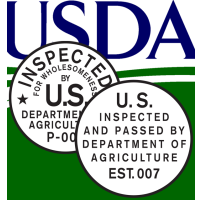USDA Program Allowing Pork Plants to Inspect Themselves Fails to Prevent Contaminated Meat

The U.S. Department of Agriculture (USDA) spent 15 years sponsoring a pilot program that involved pork-processing plants speeding up operations while taking on a greater role in inspecting meat to ensure safety. USDA officials concluded that the new system failed to stop the production of contaminated meat—and yet, the agency wants to now expand this flawed process to all pork producers in the United States.
The pilot project was used at five American hog plants, and a similar program was also tested in select countries that export red meat to the U.S. It allowed producers to increase the speed of processing lines by as much as 20%, and it reduced the number of USDA safety inspectors by 50% at each plant, replacing them with private inspectors employed by the companies.
A program of this sort had long been advocated by the meat industry, and its initial launch in 1997 was hailed by meat producers because the reduced government oversight and increased rate of processing would mean greater profits. The government also saw the chance to save millions of dollars per year due to reducing the number of its meat inspectors.
At the time, the USDA promised it would study the effectiveness of the new inspection program. But it never did.
Now a report (pdf) issued by the USDA Office of the Inspector General (IG) shows that the 15-year experiment has proven to be a disaster for the health and safety of American and foreign consumers alike.
Among the five U.S. facilities participating in the test program, three of them landed on the government’s list of the 10 worst offenders in the country for health and safety violations, including failures to remove fecal matter from meat, according to the report.
In addition, the plant with the worst record was one of the five in the pilot program.
One piece of good news: Contaminated meat at these plants never made it to market because government inspectors caught it at the end of the processing line. But this kind of situation is considered too late in the process to effectively protect consumers from eating tainted meat.
A similar system of self-inspection by meat producers was also allowed at plants in Canada and Australia that export their beef products to the U.S. In the last two years, these facilities have “experienced a rash of problems,” according to The Washington Post.
One of the Canadian plants wound up recalling nearly nine million pounds of beef and beef products tainted with E. coli — about 2.5 million pounds of which went to the U.S. market.
The speeding up of processing lines was partly blamed for the contamination, according to Canadian government safety inspectors.
The Post’s Kimberly Kindy wrote: “And since the beginning of last year, 11 shipments of beef, mutton and goat meat from at least four Australian plants using the procedures were stopped at U.S. ports because of contamination, which included fecal matter and partly digested food, records show.”
A week before the IG issued its critical report, USDA undersecretary for food safety Elisabeth Hagen praised the inspection methods and told an industry trade publication that her department is “comfortable [with] and confident in” the program’s safety results.
The USDA told the IG that it was still conducting its own evaluation of the pilot project, but that it was hoping to not only keep it around, but also expand it to all pork plants in the U.S.
Meanwhile, the agency has tested a similar program at dozens of American chicken plants. USDA officials plan to finalize regulations this year that will authorize all chicken and turkey processing facilities to use it.
While the USDA forges ahead with its plans, interviews with six meat safety inspectors added to the ugly picture already painted by the IG report. Speaking to the Post, they said that any attempt that workers make to slow down the processing lines or complain about inadequate safety procedures results in intimidation and threats by management. Additionally, they warned that the safety of the meat has been compromised by the reduction in inspectors.
“We are no longer in charge of safety,” one veteran inspector told the Post. “That’s what the public needs to know.”
-Noel Brinkerhoff, Danny Biederman
To Learn More:
USDA Pilot Program Fails to Stop Contaminated Meat (by Kimberly Kindy, Washington Post)
At Chicken Plants, Chemicals Blamed for Health Ailments are Poised to Proliferate (by Kimberly Kindy, Washington Post)
Food Safety and Inspection Service – Inspection and Enforcement Activities at Swine Slaughter Plants (USDA Office of the Inspector General) (pdf)
Millions of Pounds of Meat Shipped without being Inspected (by Noel Brinkerhoff, AllGov)
USDA Proposes Privatizing Poultry Inspections (by Noel Brinkerhoff, AllGov)
- Top Stories
- Unusual News
- Where is the Money Going?
- Controversies
- U.S. and the World
- Appointments and Resignations
- Latest News
- Trump to Stop Deportations If…
- Trump Denounces World Series
- What If China Invaded the United States?
- Donald Trump Has a Mental Health Problem and It Has a Name
- Trump Goes on Renaming Frenzy






Comments